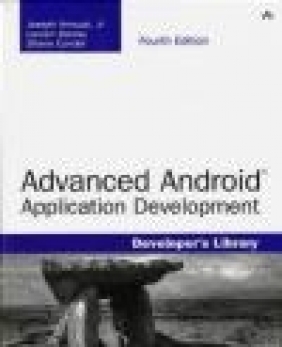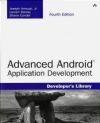Advanced Android Application Development
Lauren Darcey, Shane Conder, Joseph Annuzzi
Advanced Android Application Development
Lauren Darcey, Shane Conder, Joseph Annuzzi
- Producent: Addison Wesley Publishing Company
- Rok produkcji: 2014
- ISBN: 9780133892383
- Ilość stron: 624
- Oprawa: Miękka
Niedostępna
Opis: Advanced Android Application Development - Lauren Darcey, Shane Conder, Joseph Annuzzi
Advanced Android(TM) Application Development, Fourth Edition, is the definitive guide to building robust, commercial-grade Android apps. Systematically revised and updated, this guide brings together powerful, advanced techniques for the entire app development cycle, including design, coding, testing, debugging, and distribution. With the addition of quizzes and exercises in every chapter, it is ideal for both professional and classroom use. An outstanding practical reference for the newest Android APIs, this guide provides in-depth explanations of code utilizing key API features and includes downloadable sample apps for nearly every chapter. Together, they provide a solid foundation for any modern app project. Throughout, the authors draw on decades of in-the-trenches experience as professional mobile developers to provide tips and best practices for highly efficient development. They show you how to break through traditional app boundaries with optional features, including the Android NDK, Google Analytics and Android Wear APIs, and Google Play Game Services. New coverage in this edition includes * Integrating Google Cloud Messaging into your apps * Utilizing the new Google location and Google Maps Android APIs * Leveraging in-app billing from Google Play, as well as third-party providers * Getting started with the Android Studio IDE * Localizing language and using Google Play App Translation services * Extending your app's reach with Lockscreen widgets and DayDreams * Leveraging improvements to Notification, Web, SMS, and other APIs Annuzzi has released new source code samples for use with Android Studio. The code updates are posted to the associated blog site: http://advancedandroidbook.blogspot.com/ This title is an indispensable resource for intermediate- to advanced-level Java programmers who are now developing for Android, and for seasoned mobile developers who want to make the most of the new Android platform and hardware. This revamped, newly titled edition is a complete update of Android(TM) Wireless Application Development, Volume II: Advanced Topics, Third Edition. "This new edition of Advanced Android(TM) Application Development updates the definitive reference for Android developers, covering all major revisions of Android, including Android L. Whether you're just getting started, or need to brush up on the latest features of Android, this should be the first book you reach for." -Ray Rischpater, senior software engineer, Microsoft "This is the most comprehensive reference for programming Android. I still turn to it when I need to learn about a topic I am not familiar with." -Douglas Jones, senior software engineer, Fullpower Technologies "The problem with many Android development titles is that they either assume the developer is completely new to development or is already an expert. Advanced Android(TM) Application Development, Fourth Edition, cuts the fluff and gets to the need to know of modern Android development." -Phil Dutson, solution architect for mobile and UX, ICON Health & Fitness "Advanced Android(TM) Application Development, Fourth Edition, is an excellent guide for software developers, quality assurance personnel, and project managers who want to learn to plan, develop, and manage professional Android applications. The book explains several advanced Android topics through step-by-step running examples. The authors have done a great job explaining various Android APIs for threading, networking, location-based services, hardware sensors, animation, graphics, and more. This book is a classic investment." -B.M. Harwani, author, The Android(TM) Tablet Developer's CookbookAcknowledgments xxxiii About the Authors xxxv Introduction 1 Who Should Read This Book? 1 How This Book Is Structured 1 Key Questions Answered in This Book 3 An Overview of Changes in This Edition 4 The Development Environment Used in This Book 5 Supplementary Materials Available 6 Where to Find More Information 6 Conventions Used in This Book 7 Contacting the Authors 8 Part I: Advanced Android Application Design Principles 9 Chapter 1: Threading and Asynchronous Processing 11 The Importance of Processing Asynchronously 11 Working with the AsyncTask Class 12 Working with the Thread Class 15 Working with Loaders 16 Understanding StrictMode 17 Summary 17 Quiz Questions 17 Exercises 18 References and More Information 18 Chapter 2: Working with Services 19 Determining When to Use Services 19 Understanding the Service Lifecycle 20 Creating a Service 20 Controlling a Service 25 Implementing a Remote Interface 26 Implementing a Parcelable Class 28 Using the IntentService Class 30 Summary 33 Quiz Questions 34 Exercises 34 References and More Information 34 Chapter 3: Leveraging SQLite Application Databases 35 Storing Structured Data Using SQLite Databases 35 Querying SQLite Databases 40 Closing and Deleting a SQLite Database 45 Designing Persistent Databases 46 Binding Data to the Application User Interface 48 Summary 53 Quiz Questions 54 Exercises 54 References and More Information 54 Chapter 4: Building Android Content Providers 55 Acting as a Content Provider 55 Enhancing Applications Using Content Providers 62 Summary 65 Quiz Questions 65 Exercises 65 References and More Information 65 Chapter 5: Broadcasting and Receiving Intents 67 Sending Broadcasts 67 Receiving Broadcasts 69 Securing Application Broadcasts 73 Summary 74 Quiz Questions 74 Exercises 75 References and More Information 75 Chapter 6: Working with Notifications 77 Notifying the User 77 A Word on Compatibility 78 Notifying with the Status Bar 78 Vibrating the Phone 84 Blinking the Lights 84 Making Noise 86 Customizing the Notification 86 Expandable and Contractible Notifications 88 Notification Priority 90 Introducing the Notification Listener 91 Designing Useful Notifications 91 Summary 92 Quiz Questions 92 Exercises 92 References and More Information 92 Part II: Advanced Android User Interface Design Principles 95 Chapter 7: Designing Powerful User Interfaces 97 Following Android User Interface Guidelines 97 Enabling Action Bars 98 Working with Styles 106 Working with Themes 111 Summary 113 Quiz Questions 113 Exercises 113 References and More Information 114 Chapter 8: Handling Advanced User Input 115 Working with Textual Input Methods 115 Handling User Events 119 Working with Gestures 123 Handling Screen Orientation Changes 134 Summary 137 Quiz Questions 137 Exercises 137 References and More Information 137 Chapter 9: Designing Accessible Applications 139 Exploring the Accessibility Framework 139 Leveraging Speech Recognition Services 141 Leveraging Text-to-Speech Services 145 Testing Application Accessibility 147 Summary 147 Quiz Questions 148 Exercises 148 References and More Information 148 Chapter 10: Development Best Practices for Tablets, TVs, and Wearables 151 Understanding Device Diversity 151 Developing Applications for Tablets 154 Developing Applications for TV 155 Developing Applications for Wearables 158 Summary 159 Quiz Questions 159 Exercises 159 References and More Information 160 Part III: Leveraging Common Android APIs 161 Chapter 11: Using Android Networking APIs 163 Understanding Mobile Networking Fundamentals 163 Understanding StrictMode with Networking 164 Accessing the Internet (HTTP) 164 Summary 173 Quiz Questions 173 Exercises 174 References and More Information 174 Chapter 12: Using Android Web APIs 175 Browsing the Web with WebView 175 Building Web Extensions 182 Debugging WebViews with Chrome DevTools 187 Working with Adobe AIR and Flash 187 Summary 188 Quiz Questions 188 Exercises 189 References and More Information 189 Chapter 13: Using Android Multimedia APIs 191 Working with Multimedia 191 Working with the Camera 192 Working with Video 200 Working with Face Detection 203 Working with Audio 204 Searching for Multimedia 207 Working with Ringtones 208 Introducing the Media Router 209 Summary 209 Quiz Questions 209 Exercises 210 References and More Information 210 Chapter 14: Using Android Telephony APIs 211 Working with Telephony Utilities 211 Using SMS 216 Making and Receiving Phone Calls 220 Working with SIP 222 Summary 223 Quiz Questions 223 Exercises 223 References and More Information 224 Chapter 15: Accessing Android's Hardware Sensors 225 Interacting with Device Hardware 225 Using the Device Sensors 226 Sensor Event Batching 230 Monitoring the Battery 231 Summary 232 Quiz Questions 233 Exercises 234 References and More Information 234 Chapter 16: Using Android's Optional Hardware APIs 235 Working with Bluetooth 235 Working with USB 239 Working with Android Beam 241 Working with Wi-Fi 245 Summary 248 Quiz Questions 248 Exercises 249 References and More Information 249 Part IV: Leveraging Google APIs 251 Chapter 17: Using Location and Map APIs 253 Incorporating Android Location APIs 253 Incorporating Google Location Services APIs 260 Incorporating Google Maps Android API v2 262 Summary 268 Quiz Questions 268 Exercises 269 References and More Information 269 Chapter 18: Working with Google Cloud Messaging 271 An Overview of GCM 271 What Alternatives to GCM Exist? 274 Summary 275 Quiz Questions 275 Exercises 275 References and More Information 276 Chapter 19: An Overview of In-App Billing APIs for Android 277 What Is In-App Billing? 277 Using In-App Billing 278 Leveraging Google Play In-App Billing APIs 279 Leveraging Amazon Appstore for Android In-App Purchasing APIs 280 Leveraging PayPal Billing APIs 280 Leveraging Other Billing APIs 280 Summary 280 Quiz Questions 281 Exercises 281 References and More Information 281 Chapter 20: Enabling Application Statistics with Google Analytics 283 Creating a Google Account for Analytics 283 Adding the Library to Your Android IDE Project 286 Collecting Data from Your Applications 287 Logging Different Events 287 Using the Google Analytics Dashboard 288 Gathering E-commerce Information 290 Tracking Ad and Market Referrals 292 Gathering Statistics 292 Protecting Users' Privacy 293 Summary 293 Quiz Questions 293 Exercises 294 References and More Information 294 Chapter 21: An Overview of Google Play Game Services 295 Getting Up and Running with Google Play Game Services 295 Incorporating Google Play Game Services into Your Applications 296 Understanding Achievements 297 Understanding Leaderboards 298 Saving Game Data with Cloud Save 299 Introducing Multiplayer Gaming 299 Understanding Antipiracy 299 Summary 300 Quiz Questions 300 Exercises 300 References and More Information 301 Part V: Drawing, Animations, and Graphics Programming with Android 303 Chapter 22: Developing Android 2D Graphics Applications 305 Drawing on the Screen 305 Working with Text 310 Working with Bitmaps 312 Working with Shapes 315 Leveraging Hardware Acceleration Features 324 Summary 326 Quiz Questions 326 Exercises 326 References and More Information 327 Chapter 23: Working with Animation 329 Animating Your Applications 329 Working with Different Interpolators 341 Animating Activity Launch 341 State Animations with Scenes and Transitions 342 Summary 342 Quiz Questions 342 Exercises 343 References and More Information 343 Chapter 24: Developing Android 3D Graphics Applications 345 Working with OpenGL ES 345 Using OpenGL ES APIs in the Android SDK 347 Handling OpenGL ES Tasks Manually 347 Drawing 3D Objects 353 Interacting with Android Views and Events 362 Cleaning Up OpenGL ES 365 Using GLSurfaceView (Easy OpenGL ES) 366 Using OpenGL ES 2.0 369 Exploring OpenGL ES 3.0 373 Summary 374 Quiz Questions 374 Exercises 374 References and More Information 375 Chapter 25: Using the Android NDK 377 Determining When to Use the Android NDK 377 Installing the Android NDK 378 Exploring the Android NDK Sample Application 379 Creating Your Own NDK Project 379 Improving Graphics Performance 384 Comparing RenderScript to the NDK 385 Summary 386 Quiz Questions 386 Exercises 386 References and More Information 386 Part VI: Maximizing Android's Unique Features 389 Chapter 26: Extending Android Application Reach 391 Enhancing Your Applications 391 Working with App Widgets 392 Working with Live Wallpapers 404 Creating a Live Wallpaper 404 Introducing Daydream 408 Acting as a Content Type Handler 410 Determining Intent Actions and MIME Types 411 Summary 413 Quiz Questions 413 Exercises 414 References and More Information 414 Chapter 27: Enabling Application Search 415 Making Application Content Searchable 415 Enabling Searches in Your Application 416 Enabling Global Search 424 Summary 426 Quiz Questions 426 Exercises 426 References and More Information 426 Chapter 28: Managing User Accounts and Synchronizing User Data 427 Managing Accounts with the Account Manager 427 Synchronizing Data with Sync Adapters 429 Using Backup Services 430 Summary 435 Quiz Questions 436 Exercises 436 References and More Information 436 Part VII: Advanced Topics in Application Publication and Distribution 437 Chapter 29: Internationalizing Your Applications 439 Localizing Your Application's Language 439 Right-to-Left Language Localization 445 Translation Services through Google Play 445 Publishing Applications for Foreign Users 446 Summary 446 Quiz Questions 446 Exercises 447 References and More Information 447 Chapter 30: Protecting Applications from Software Piracy 449 All Applications Are Vulnerable 449 Using Secure Coding Practices 450 Obfuscating with ProGuard 450 Leveraging the License Verification Library 452 Other Antipiracy Tips 453 Summary 454 Quiz Questions 454 Exercises 455 References and More Information 455 Part VIII: Preparing for Future Android Releases 457 Chapter 31: Introducing the L Developer Preview 459 Exploring the L Developer Preview 459 Introducing Android TV 464 Summary 465 Quiz Questions 465 Exercises 466 References and More Information 466 Part IX: Appendixes 467 Appendix A: Quick-Start Guide: Android Debug Bridge 469 Listing Connected Devices and Emulators 469 Directing ADB Commands to Specific Devices 470 Starting and Stopping the ADB Server 470 Listing ADB Commands 470 Issuing Shell Commands 471 Copying Files 472 Installing and Uninstalling Applications 473 Working with LogCat Logging 474 Controlling the Backup Service 476 Generating Bug Reports 477 Using the Shell to Inspect SQLite Databases 478 Using the Shell to Stress Test Applications 478 Installing Custom Binaries via the Shell 481 Summary 482 Quiz Questions 482 Exercises 483 References and More Information 483 Appendix B: Quick-Start Guide: SQLite 485 Exploring Common Tasks with SQLite 485 Using the sqlite3 Command-Line Interface 486 Learning by Example: A Student Grade Database 491 Summary 497 Quiz Questions 498 Exercises 498 References and More Information 498 Appendix C: Java for Android Developers 499 Learning the Java Programming Language 499 Learning the Java Development Tools 499 Familiarizing Yourself with Java Documentation 500 Understanding Java Shorthand 500 Summary 505 Quiz Questions 505 Exercises 505 References and More Information 505 Appendix D: Quick-Start Guide: Android Studio 507 Getting Up and Running with Android Studio 507 Understanding the Android Studio Project Structure 512 Learning about the Gradle Build System 513 Overview of the Android Studio User Interface 513 Introducing the Layout Editor 513 Debugging Your Android Studio Applications 515 Useful Keyboard Shortcuts 517 Summary 517 Quiz Questions 517 Exercises 518 References and More Information 518 Appendix E: Answers to Quiz Questions 519 Index 527
Szczegóły: Advanced Android Application Development - Lauren Darcey, Shane Conder, Joseph Annuzzi
Tytuł: Advanced Android Application Development
Autor: Lauren Darcey, Shane Conder, Joseph Annuzzi
Producent: Addison Wesley Publishing Company
ISBN: 9780133892383
Rok produkcji: 2014
Ilość stron: 624
Oprawa: Miękka
Waga: 0.96 kg





























